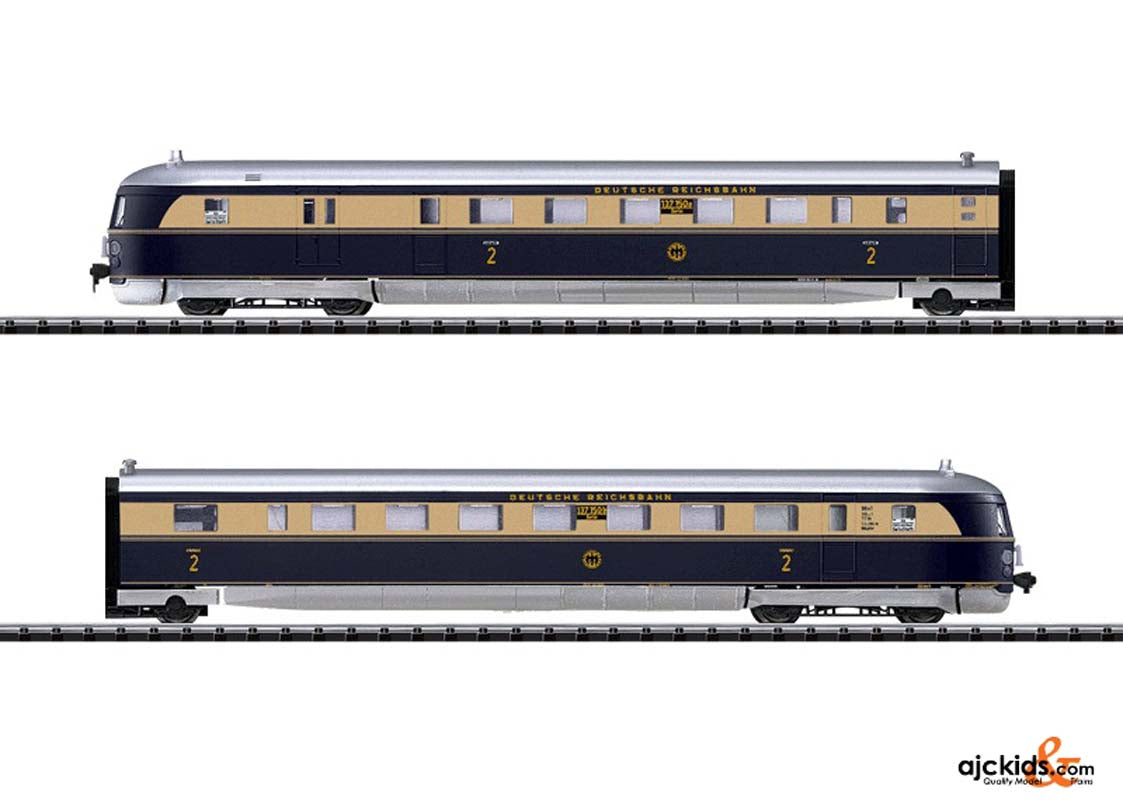Trix 12437 - Diesel Railcar
Highlights
- Close coupler mechanism between the car halves.
- Digital connector.
- White/red headlight / marker light changeover.
- Interior lighting.
Product description
Model: Era II, the powered rail car comes with a digital connector, 2 axles powered, 2 traction tires. It has interior lighting with LED's, the headlights are LED's, and the headlights / marker lights change over white/red with the direction of travel. The center Jacobs truck is connected to both car halves with a guide mechanism. On straight track the rail car set has prototypically correct close spacing with no gaps.
Total length 278 mm / 10-15/16".
Publications
- New Items 2004 - Main Catalog 2004 / 2005 - Main Catalog 2006Prototype information
In the 1920s the German State Railroad Company was experiencing increased competition. The automobile and the airplane made traveling more individual and faster. The day trip - out in the morning, back in the evening - became an attractive product for business people and the well off. If the railroad did not want to lose these customers, it had to become faster. After initial experiments with the Rail Zeppelin (that set a world record of 230 km/h or 144 mph for railroad motive power that lasted 24 years), the railroad ordered a 2-unit combustion powered rail car. It was placed into service in May of 1932 and linked the two metropolitan areas of Berlin and Hamburg. This express rail car raced over the 228 km or 143 mile long route in 132 minutes. With an average speed of almost 128 km/h or 80 mph, it was the fastest regularly scheduled train in the world and entered history as the "Fliegender Hamburger" or "Flying Hamburger". The success of this new express passenger service was immense, and the German State Railroad ordered additional powered rail cars. This Hamburg Design is the prototype for our model. The SVT 137 was equipped with improvements in design, a different end design, and was also equipped for double unit operation. The propulsion system worked on the diesel-electric principle. A unit consisting of a 12-cylinder diesel motor and a generator sits on each of the two end trucks. It functions as a power plant and generates the current for the electric traction motors. The latter are mounted on the two axles of the center Jacobs truck, which connects the two car halves. The SVT express passenger service was quickly expanded. The Hamburg Design ran from and to Berlin. There was also a direct connection to Köln, Frankfurt, Leipzig, Stuttgart, and Munich, as well as between Hamburg and Köln. The German State Railroad held the class 03 streamlined steam locomotives in reserve as a backup. They could spring into action with a 3-car consist, if an SVT should fail. In contrast to the preproduction prototype, the Hamburg Design was equipped with multiple unit control. The route from Berlin to the South was run with double units. In Nürnberg, the two powered rail cars were uncoupled from one another, and they ran individually on to Stuttgart and Munich. The train crew and station personnel were trained for this maneuver in order not to lose any time. After just a minute"s stop, the first train would depart, followed moments later by the second train. On the return trip both units were coupled together again in Nürnberg. We know this kind of double unit operation today from the ICE 2.
Features
Warning
EAN/UPC: 4028106124372



